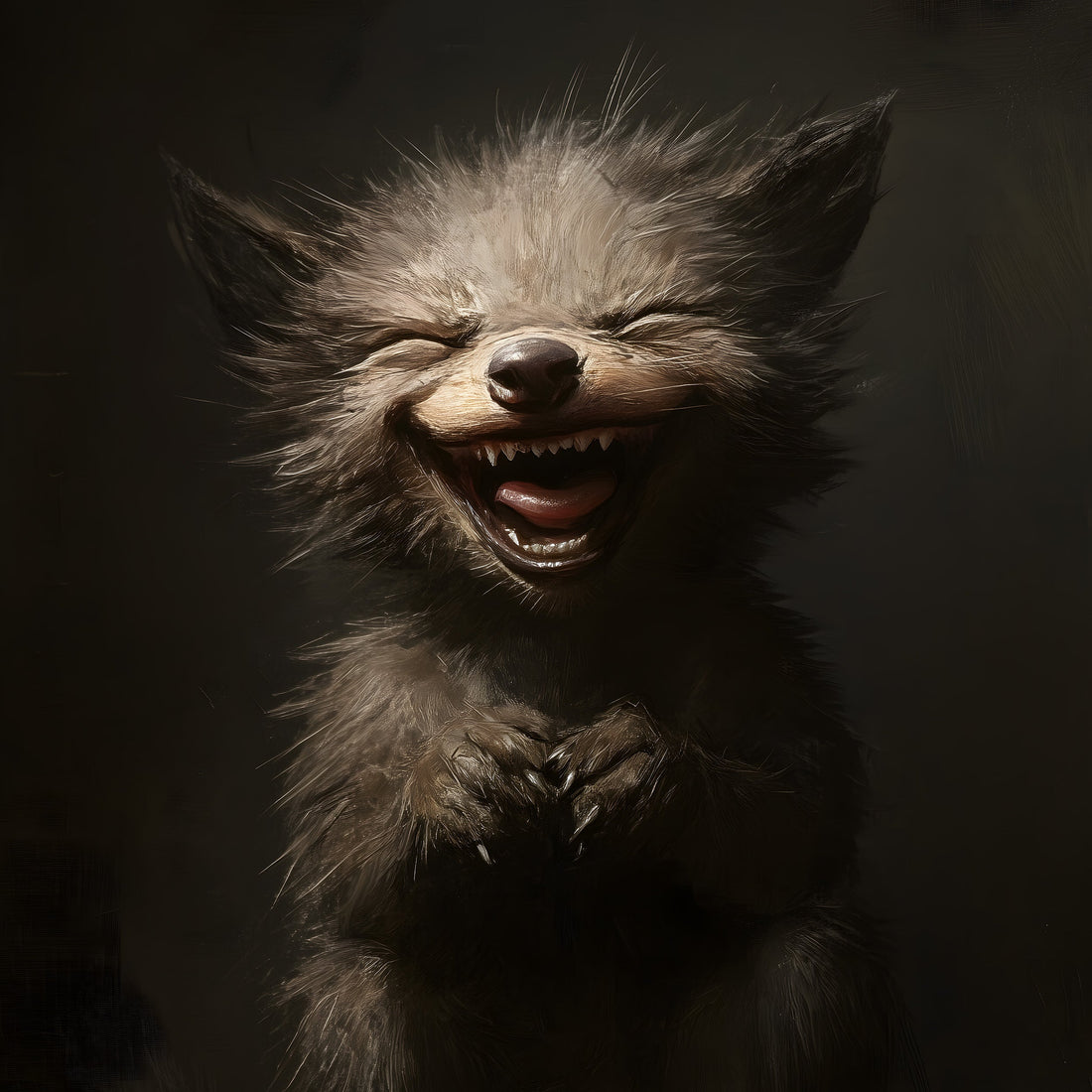
Does humor have a place in dark art?
ChristianShare
Ever found yourself staring at a piece of art that’s all doom and gloom, maybe a few skeletons lurking, a general air of "the world is ending," and then… you chuckle? If you have, you’re not alone, and you’re definitely in the right place. I’ve spent countless hours wandering through galleries (both physical and virtual, bless the internet) soaking in the shadows, and I’ve often pondered this very question: Does humor really have a place in dark art? Or is it like inviting a clown to a vampire’s tea party – just a bit… off? IMO, it’s not just a place, but often a brilliant one. Let's chat about why.
What Even IS "Dark Art"? Let's Not Get Spooked By Semantics
Before we dive into the giggles amidst the gloom, what are we even talking about when we say "dark art"? It's a broad term, isn't it? It can conjure images of gothic cathedrals, angsty poetry, or maybe just your cousin’s heavy metal album covers.
More Than Just a Moody Teenager's Sketchbook
Seriously though, dark art is much more than just an aesthetic preference for the color black. It often explores some pretty heavy themes:
- Mortality: You know, the small, insignificant fact that we’re all shuffling off this mortal coil. Cheery!
- The Macabre & Grotesque: Think unsettling, bizarre, sometimes downright stomach-churning imagery. It’s not always pretty, but it’s often fascinating.
- The Surreal & Psychological: This is where art gets into your head, exploring dreams, fears, and the weirder corners of the human psyche.
- Societal Critique: Sometimes, the "darkness" isn't supernatural; it's a reflection of the unsettling truths about our world.
Artists like Zdzisław Beksiński painted nightmarish landscapes, while Francisco Goya’s "Black Paintings" delved into human despair and violence. The point isn't just to be spooky; it's to evoke something profound.
The "Dark" Part: It's About Evoking Emotions
Ultimately, dark art aims to make you feel something. That could be discomfort, introspection, a shiver down your spine, or even a strange sense of beauty in the shadows. It challenges us, makes us confront things we might rather ignore. So, if it’s all so serious, where’s the punchline?
Okay, So Where Does Laughter Fit Into This Gloomfest?
This is where it gets really interesting. If dark art is busy making us ponder our inevitable demise, how can a chuckle possibly fit in? Well, surprisingly effectively, as it turns out.
The Surprise Guest: Why Humor Can Be So Effective
Imagine you’re watching the most intense horror movie, and suddenly there’s a moment of unexpected, brilliant humor. Doesn’t it almost heighten the tension afterward? Humor in dark art can work in similar ways:
- Contrast is King: A flash of wit or absurdity in a somber piece can make the darker elements hit even harder. It’s like a sudden spotlight in a pitch-black room; you notice what it illuminates all the more. I’ve seen pieces where a tiny, almost comical detail in an otherwise grim scene completely changes the impact.
- A Necessary Relief Valve: Let’s be honest, constantly staring into the abyss can be exhausting. Humor can provide a much-needed breather, allowing us to process difficult themes without being utterly overwhelmed. It’s the sugar that helps the medicine go down, so to speak.
- Making the Unpalatable Palatable: Some subjects are just plain tough. Humor can act as a bridge, making challenging or disturbing ideas more accessible. It can disarm us, allowing us to engage with topics we might otherwise shy away from. Ever tried to explain a complex, dark concept to someone? Sometimes a bit of humor is the only way to get them listening.
Different Flavors of Funny in the Shadows
Not all humor in dark art is a pie to the face (though, that could be… interesting). There are different shades to this gallows humor:
- Dark Humor/Black Comedy: This is the big one. It’s finding the funny in the tragic, the taboo, the truly awful. Think laughing at the sheer absurdity of a terrible situation. Why do we do it? Maybe it’s a coping mechanism, or maybe some things are so bleak, laughter is the only sane response.
- Satire: This is humor with a sharp edge. Artists use satire to critique societal flaws, hypocrisy, or power structures, often cloaking their criticisms in dark or grotesque imagery. Goya was a master of this, using his art to take aim at the follies of his time.
- The Grotesque and Absurd: Remember those bizarre, hybrid creatures in medieval manuscript margins? Or the unsettlingly strange figures in a Hieronymus Bosch painting? There’s often an inherent, albeit disturbing, humor in the truly outlandish and absurd. It’s a "what on earth am I looking at, and why do I find it slightly amusing?" kind of feeling.
- Irony: Ah, irony. The lifeblood of many a dark artwork. The gap between what’s expected and what happens, or what’s said versus what’s meant, can be a potent source of grim chuckles. Dark art often revels in these ironic twists.
Artists Who Walked the Tightrope (And Didn't Fall... Mostly)
Plenty of artists throughout history have brilliantly blended the dark with the droll. They prove that humor in dark art isn't a newfangled idea; it's a long-standing tradition.
The Old Masters of Macabre Merriment
You might be surprised by how many "serious" artists had a wicked sense of humor lurking in their work:
- Hieronymus Bosch: Take a close look at "The Garden of Earthly Delights." Amidst the depictions of sin and damnation, there are scenes so bizarre and inventive, you can’t help but detect a glint of dark, fantastical humor. Butt-trumpets, anyone?
- Francisco Goya: His series of etchings, "Los Caprichos," is a masterclass in social satire. He used monstrous figures and dark allegory to mock the superstitions, corruption, and general foolishness of Spanish society. It's biting, unsettling, and yes, darkly humorous.
- Pieter Bruegel the Elder: Works like "The Triumph of Death" are undeniably grim, yet look closer at the individual scenes within his chaotic tableaus. There's a certain folk-tale absurdity, a grim carnival feel that almost borders on the comical in its sheer, relentless bleakness.
Modern Mavericks of Morbid Mirth
The tradition continued, with modern and contemporary artists finding new ways to inject humor into their explorations of the dark:
- The Surrealists: Artists like Salvador Dalí and René Magritte often played with the illogical and dreamlike. Their work can be deeply unsettling, but there’s frequently a layer of witty absurdity or visual puns that elicit a smile, even if it’s a confused one.
- Contemporary Examples: Think of artists like Maurizio Cattelan, whose work often provokes with a shocking, darkly humorous twist (like his sculpture of the Pope being hit by a meteorite, "La Nona Ora"). Or consider graphic novelists like Charles Burns ("Black Hole"), whose unsettling body horror is sometimes infused with a deeply uncomfortable, almost bleakly funny portrayal of teenage angst. I once saw a piece by a lesser-known contemporary sculptor – a series of tiny, exquisitely detailed dioramas of mundane office spaces, but with miniature skeletons as the employees, all engaged in comically relatable office drudgery. It was both hilariously bleak and profoundly sad. That stuck with me.
- Pop Surrealism/Lowbrow Art: Many artists in this movement, like Mark Ryden or Todd Schorr, blend cute, kitschy aesthetics with unsettling, sometimes grotesque, elements. The juxtaposition itself often creates a humorous, albeit slightly twisted, effect.
But Is It Always Appropriate? The Fine Line
Okay, so humor can work in dark art. But is it a free-for-all? Can you just slap a clown nose on a depiction of existential dread and call it a day? Probably not. There’s a fine line, and sometimes artists stumble.
When Funny Falls Flat (Or Worse, Offends)
Injecting humor into sensitive or tragic subjects is tricky business. What works for one person might be deeply offensive to another.
- Trivializing Serious Issues: This is the biggest risk. If the humor isn't handled with intelligence and sensitivity, it can come across as making light of real suffering or complex problems. The art might lose its power or, worse, seem disrespectful.
- Punching Down: Humor that targets already marginalized or vulnerable groups, especially within a "dark art" context that might already be exploring themes of suffering, is just... not cool. It can reinforce harmful stereotypes instead of challenging them.
- Intent vs. Impact: An artist might intend their work to be a clever, satirical commentary, but if the audience perceives it as merely cruel, flippant, or confusing, then it’s failed. This is a constant dance for artists working in this space. I remember seeing a piece that tried to be funny about mental illness, and it just felt... icky. :/
The Artist's Intent: Key or Irrelevant?
This leads to a classic art debate: How much does the artist's intention matter versus your own interpretation? If an artist swears their painting of a tormented soul slipping on a banana peel is a profound statement on the human condition, but you just see slapstick, who's right? IMO, both perspectives have validity. The artist’s intent provides context, but art truly comes alive in the viewer's experience. Sometimes, accidental humor can even add an unexpected layer to a dark piece, can't it?
Why We're Drawn To This Twisted Tango: The Psychology Bit (Lightly!)
So why do we, as audiences, often enjoy this blend of darkness and humor? What’s the appeal of a good old-fashioned macabre chuckle?
Catharsis and Coping
Life throws some serious curveballs. Death, loss, anxiety, the general absurdity of existence – it’s a lot. Humor, especially dark humor, can be an incredible coping mechanism. It allows us to confront these difficult truths from a slightly safer distance. Laughing in the face of the abyss can be surprisingly cathartic. As I sometimes say, if you don't laugh at the darkness, you might just end up marinating in it.
The Intellectual Itch
There's something intellectually stimulating about art that plays with these contrasts. It challenges our expectations and makes us think. Deciphering the layers of meaning in a satirical piece or appreciating the cleverness of a darkly witty juxtaposition can be genuinely rewarding. It’s like solving a puzzle, but with more existential dread and occasional giggles.
Embracing the Full Spectrum of Human Emotion
Let’s face it, human experience isn't a neat little box. We’re capable of feeling joy and sorrow, fear and amusement, often all at once. Art that reflects this complexity, this messy blend of light and shadow, often feels more authentic and relatable. It acknowledges that even in the darkest moments, a spark of absurdity or a moment of levity can exist. And isn't that a more honest portrayal of life?
Conclusion: So, Does Humor Belong? You Bet Your Gloomy Boots It Does!
So, after all this chin-stroking and art-gazing, what’s the verdict on whether humor has a place in dark art? For me, it’s a resounding YES. When wielded with intelligence, skill, and a bit of finesse, humor doesn't diminish the power of dark art; it can actually amplify it.
It offers contrast that sharpens the shadows, provides relief that makes the darkness bearable, and serves as a vehicle for potent critique and satire. It allows artists and audiences alike to engage with difficult subjects in a more nuanced, and sometimes more profound, way. And frankly, it can make the exploration of life's darker corners a bit more… entertaining.
So, the next time you’re contemplating a piece of art that’s giving you the creeps, don’t be afraid to look for that little smirk, that hidden joke, that glint of irony in its shadowy depths. You might find that the darkness is a lot more interesting, and perhaps even a little funnier, than you initially thought. Go on, embrace the gloom, and if you find yourself chuckling, know that the artist might just be winking right back at you. ;)














